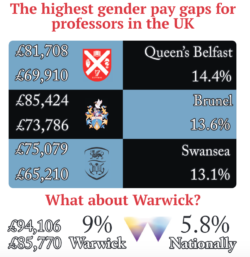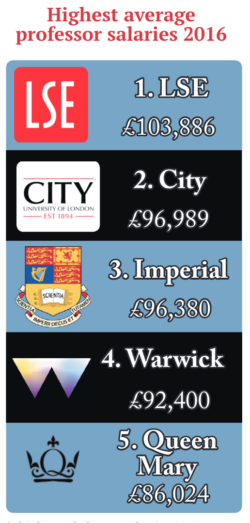Gender pay gap for Warwick academics revealed
A Freedom of Information (FOI) request sent by The Boar reveals the extent of the gender pay gap at the University of Warwick for academic staff from 2014 to 2017.
Over the past three years, 34 equality adjustments have been made at the University. An equality adjustment is a case where a gap was identified between the remuneration of males and females in similar roles, which was subsequently rectified.
According to the FOI response, 21 equality adjustments were made in 2015 for females and fewer than five (the exact number cannot be specified due to the Data Protection Act) equality adjustments were made for males between the range of £1,500 and £15,000.
In 2016/17, 13 equality adjustments were made for females and fewer than five equality adjustments were made for males between the range of £2,000 and £10,000.
The FOI also reveals some discrepancies in the annual salary of male and female heads of department. In 2014, female heads of department earned on average almost £20,000, or 22%, less than their male counterparts and almost £15,000, or 16%, less in 2017. This pay gap was smaller in 2015 and 2016, with the figures standing at £8,874 and £553 respectively.
Over the past three years, 34 equality adjustments have been made at the University, between the range of £1,500 and £15,000
One factor that could explain these wage differentials is that compensation also varies according to the size of the department. For example, in addition to their basic pay, heads of department receive an honorarium in accordance to the size of their department: £5,200 for a small department, £10,700 for a medium-sized one and £16,600 for a large one.
According to the FOI, female heads of department are more numerous in Arts and Humanities, where departments tend to be smaller, which could account, at least partially, for the difference in average remuneration.
A pay gap exists at all levels for Warwick academics. For the lowest salary band corresponding to tutors and researchers, women earn slightly more than men. In 2017, females in this category earned £215 more on average.
However, the wage gap is reversed and widens at higher levels.
Last year, for the highest salary band corresponding to professors or professorial fellows, the wage gap was 8%, meaning that women professors earned £7,756 less per annum on average. The year before, the figure was 9% and the highest such difference was in 2014, of 12% (£11,159).

According to the Times Higher Education Pay Survey 2017, the national pay gap for full-time professors in 2016 was around 5.8%, which was lower than the Warwick average of 9% in the same year. In 2016, the average female professor at Warwick earned £89,578 compared to her average male counterpart, who earned £97,940.
The survey also showed that the average salary for professors at Warwick was the fourth highest in the country (excluding specialist institutions such as London Business School and London School of Hygiene and Tropical Medicine), standing at around £92,000 per annum, behind the London School of Economics (LSE), City University of London and Imperial College London, with LSE topping the charts.
The next highest average for professors outside of London after Warwick was the University of Liverpool at £84,990.
LSE is the only institution hat pays its professors above the £100,000 mark, with their average pay coming in at about £103,000.
The University of Aberdeen, King’s College London and the University of Cambridge were in the top three last year for the highest gender pay gaps for all academics, with the figures at 17%, 16.8% and 16%. The University of Birmingham was ranked ninth, with a gap of 15.1%.
However, of the aforementioned institutions only City University of London and Aberdeen University also feature in the top ten for the highest pay gaps for full-time professors, coming in fifth with a gap of 10.5% and ninth with 9.4% respectively.
 Warwick did not feature in the top 10 of any of the rankings mentioned above.
Warwick did not feature in the top 10 of any of the rankings mentioned above.
In the case of some universities across the country, the issue of the gender pay gap spurred some internal revisions of pay structure.
According to Times Higher Education, in 2016, the University of Essex moved female professors up three newly created pay levels which in effect brought the average salaries of male and female professors to the same level.
The article says that the university’s director of human resources, Susie Morgan, admitted it was a “quick and dirty” fix that was not ideal, adding that the focus now had to be on all the other factors influencing women’s pay to keep the gap closed.
That same year, LSE also resolved to give women a pay rise, after internal analysis found a pay gap of 10.5%, even after “age, length of service and research productivity were controlled for”, according to the same publication.
The Boar also reported on the gender pay gap at Warwick SU, finding that that the difference in the mean pay of male and female employees is 5.9%.

Comments (1)